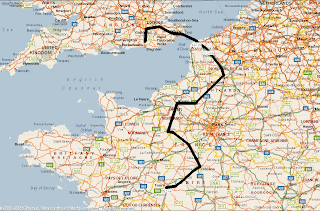 The weather, which thus far had been unseasonably cool with rain several times each day, had every indication of worsening. The frustrations of no Internet and nothing but foreign language radio stations, had reduced weather forecasting to the traditional wet finger in the air followed by a knowing nod. Based on this divination, we decided to leave the Loire valley, and skip both Poitiers and Limoge on our flight south. 200 miles later found us in Rocamadour with the weather little changed. So much for the occult!
The weather, which thus far had been unseasonably cool with rain several times each day, had every indication of worsening. The frustrations of no Internet and nothing but foreign language radio stations, had reduced weather forecasting to the traditional wet finger in the air followed by a knowing nod. Based on this divination, we decided to leave the Loire valley, and skip both Poitiers and Limoge on our flight south. 200 miles later found us in Rocamadour with the weather little changed. So much for the occult!
If nothing else, Rocamadour in Occitan, a commune of southwestern France in the canton of Gramat, arrondissement of Gourdon, department of Lot, in the diocese of Cahors and the former province of Quercy, has a grand administrative title. That wasn't the half of it, however. Rocamadour is a tiny village of about 650 people that is part carved into and part attached to, an almost sheer 400 foot high cliff face overlooking the Alzou river, a tributary of the Dordogne. Since the 12th century this location has been the focus of religious attention and wishful thinking, including numerous alleged miracles elevating it to major pilgrim status and a stop on the way to that holy of holies, Santiago de Compostella in northern Spain.
The most significant structure in the village proper, is the pilgrimage church
 of Notre Dame containing the cult image of a wooden Black Madonna reputed to have been carved by Saint Amator himself. Notre Dame is the largest building in the picture at right while the church of Saint Michel, favored by the Benedictine community, is the smaller building to its left. Two other churches, St Sauveur and, beneath it, the subterranean St Amadour, are also built in close proximity. The chateau on top of the cliff was built in the middle ages to defend this religious hodge-podge. For those with a penchant for investing in the incredible, a visit to the Grotto of Miracles might be in order. Check the walking tour
of Notre Dame containing the cult image of a wooden Black Madonna reputed to have been carved by Saint Amator himself. Notre Dame is the largest building in the picture at right while the church of Saint Michel, favored by the Benedictine community, is the smaller building to its left. Two other churches, St Sauveur and, beneath it, the subterranean St Amadour, are also built in close proximity. The chateau on top of the cliff was built in the middle ages to defend this religious hodge-podge. For those with a penchant for investing in the incredible, a visit to the Grotto of Miracles might be in order. Check the walking tour














































